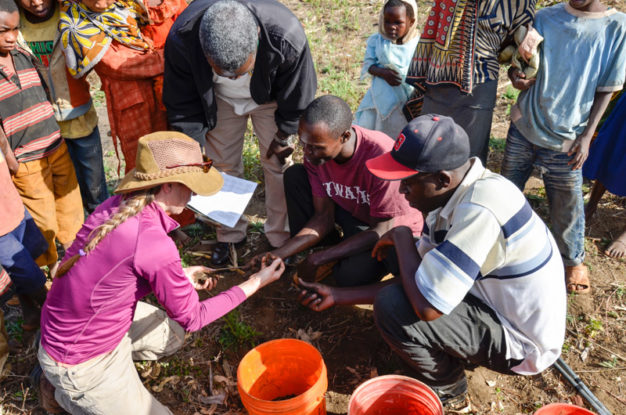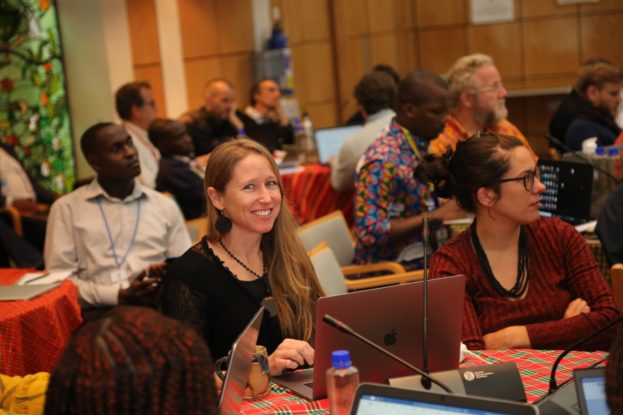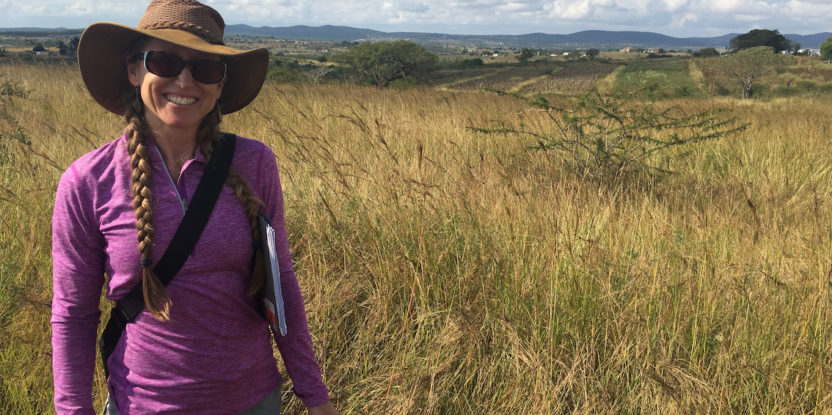Leigh Ann Winowiecki is theme leader for Soil and Land Health at World Agroforestry (ICRAF).
My father and I were discussing soil restoration the other day, which is not so surprising, given our family’s roots in farming in the U.S. state of Michigan – my grandfather even carried on that tradition when he moved into Detroit for work and rented the vacant lot next door to plant potatoes.
I’m sure he would have felt comfortable joining our soil restoration conversation; after all, it’s a universal concern. The world’s food supplies are still very deeply connected with the soil: without healthy, well-functioning soil, we cannot produce nutritious food. It’s as simple as that. When the soil in which we grow our food becomes degraded, leached of its nutritional components, the negative effects cascade all along the production chain and our food systems – and so much more – break down.
We see the negative impact in the high global rates of hunger and malnutrition, afflicting over 800 million people. This crisis is at the heart of the U.N. Food Systems Summit (UNFSS) in 2021, which will bring attention to the state of the Earth’s soil, an estimated 40 percent of which is degraded. That is a shockingly high rate, and we can easily imagine what it means for the nutritional quality of our food.
Through Action Track 3 of the UNFSS, which focuses on boosting nature-positive solutions at scale, attention will be brought to the protection of natural ecosystems; sustainable management of existing agricultural systems; and restoration of degraded ecosystems and vital soil functions for sustainable food production and food security. These goals are shared by the U.N. Decade on Ecosystem Restoration, which will be officially launched in June, and emphasizes the importance of fulfilling global, national and local restoration commitments with action on the ground.
The decade will also highlight the necessity of rebuilding the health of the planet’s soil, through collective work within communities and among partners to revitalize ecosystems, including restoring degraded soil. Only then can it fulfill such critical functions as rebuilding organic carbon stores as well as supporting the micro-organisms living within the soil and that soak up water and maintain soil health.
Such events as the decade are also an important reminder that even in the face of the grim statistics on world hunger, soil degradation and ecosystem loss, much work is underway to strengthen and restore nature-positive food production systems as well as soil health.

Leigh Ann Winowiecki demonstrates soil texture. CIFOR/Tor Vagen
Over the past five years, I’ve had the privilege of working with innovative smallholder farmers through a land restoration project in semi-arid parts of eastern Kenya, Niger, Ethiopia and Mali. Farmers there, supported by World Agroforestry (ICRAF) scientists as well as the International Center for Agricultural Research in the Dry Areas (ICARDA), the International Livestock Research Institute (ILRI), the International Crops Research Institute for the Semi-Arid Tropics (ICRISAT), and development partners, have integrated practices aimed at reducing soil erosion while increasing levels of carbon and improving the water holding capacity of severely degraded soil. The results are apparent in increased productivity and greater ecosystem services, which is also leading to improved livelihoods.
Through continuous engagement with farmers over the course of this ICRAF-led project – funded by the International Fund for Agricultural Development (IFAD) and European Commission – we’ve seen the importance of harnessing the complexity of ecosystems and applying a food-systems approach, which considers the total food system, with all its elements, sectors and relationships.
We’ve also learned valuable lessons that we can scale and apply elsewhere. One of the most valuable, perhaps, is our new understanding of the importance of tailoring restoration work to farmers’ knowledge and experience. In other words, restoration options must be locally relevant.
We’ve noticed how farmers, as they gained experience, based their approaches to restoration on their needs, the space available and their particular goals. For example, to reduce erosion and restore their soil, smallholder farmers in eastern Kenya worked the soil into basins instead of plowing their land into rows; then, they applied composted manure and mulch to return organic material into the soil. Some farmers started very small, with just a few basins, and subsequently expanded these basins in numbers and size, while some diversified the crops they planted over time.
During this project, which involved over 100,000 farming households, farmers also planted (and are tending to) some 50,000 trees across three counties in Kenya. They found that by integrating trees and crops, and by implementing tailored soil-water conservation measures, their crop yields jumped by two to six times the usual amount. Farmers benefitted from innovative agroforestry and crop diversification techniques, using these to increase food security. Intercropping was also found to increase yields significantly; in part, due to the variety of nutrients coming from different plants. Such diversification means greater nutritional benefits for humans and their soil, but also more market options for producers while boosting resilience.

Leigh Ann Winowiecki attends a science forum.
The necessity of greater resilience has been underscored by the COVID-19 pandemic, which is both a symptom and a consequence of degraded soil and ecosystems. Supported by the project during the pandemic, farmers in Eastern Kenya responded to the closing of food markets by diversifying production to grow more of their own food crops in addition to their regular staples such as maize and beans. This demonstrates the kind of creative adaptability of smallholder farmers when they have the tools and support they need to get started. Such knowledge-intensive agriculture practices on a much larger scale are essential for the significant soil and ecosystem restoration efforts required for greater food and nutritional security. This work can be supported by land and soil health assessments and the valuable information we collect from these.
We must begin to see landscape restoration as part of the solution to feeding the world. We must invest in, and scale, regenerative agricultural practices that restore critical ecosystem functions that we have lost through soil degradation. This requires a shift in terms of how we approach agriculture. Instead of working against nature, we need to work with nature and harness the natural processes to help us sustainably produce food. That means utilizing natural ecosystem processes to our benefit.
We need agricultural practices that give back to nature and give back to the soil. If we begin to truly protect soil, putting organic matter and carbon back in, the knock-on benefits will be great. The outcomes will mean more and better food, and an end to food and nutritional insecurity.
When my grandfather left the farm, he took with him the desire to continue to work with the soil, no matter where he settled; and to ensure his family’s food and nutritional security through their home vegetable garden. That is a very valuable lesson that continues to resonate today.
We want you to share Forests News content, which is licensed under Creative Commons Attribution-NonCommercial-ShareAlike 4.0 International (CC BY-NC-SA 4.0). This means you are free to redistribute our material for non-commercial purposes. All we ask is that you give Forests News appropriate credit and link to the original Forests News content, indicate if changes were made, and distribute your contributions under the same Creative Commons license. You must notify Forests News if you repost, reprint or reuse our materials by contacting forestsnews@cifor-icraf.org.
